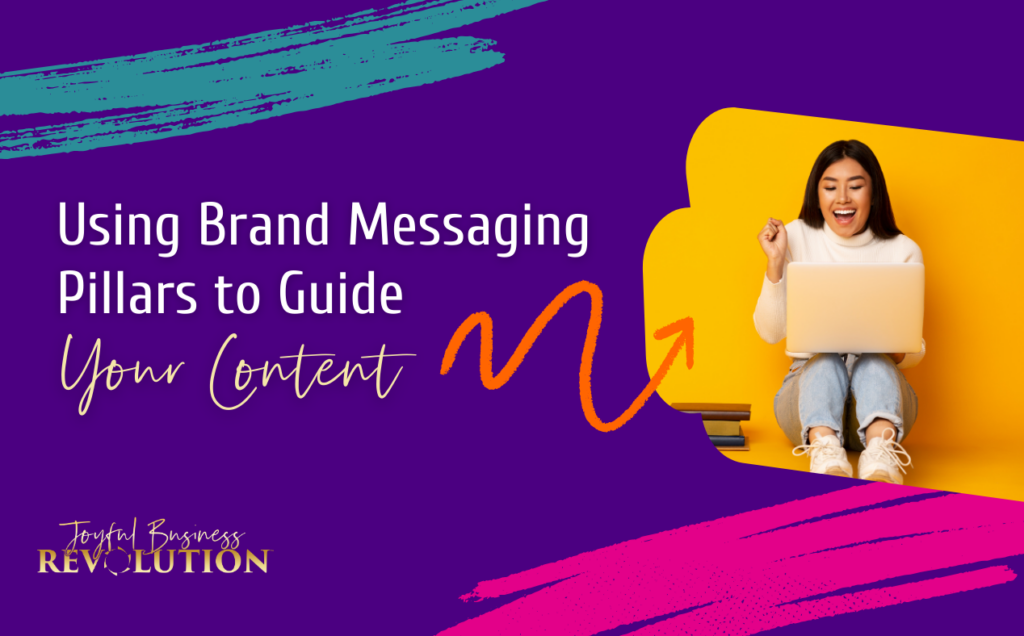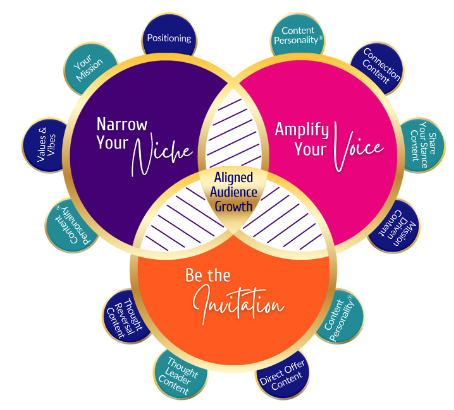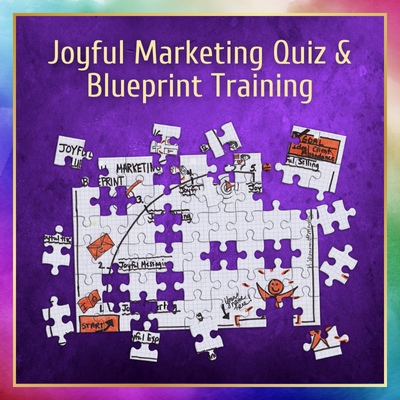When you talk to a variety of so-called digital marketing experts looking for ideas to build connections with your audience, you’ll get all kinds of different advice. Some of them might talk about how to position your business or define your USP. Others might get into tactics or suggest you identify your brand messaging pillars—but something I find is often missing is how to apply this information to your business and actually use it to grow your sales.
What I want you to know is that all of those pieces are critical for figuring out your messaging and nurturing your audience. However, it’s all too easy to get lost in all of the to-dos instead of spending time getting to the heart of your business. That’s why I’m sharing practical advice in a six-article series especially for coaches, consultants, and other experts—that’s you, by the way—so you can fine-tune your brand messaging strategy.
Today, we’re exploring how your brand messaging pillars fit into your broader messaging strategy—so you can start taking action and grow-your sales faster.
Just as importantly, I want to help you avoid the single biggest pitfall I see business owners make in the process of developing a messaging strategy.
What’s that?
While it’s important to take enough time to get it right, it can be an iterative process—and it’s just as important to focus on action, so you can test your messaging.
So there are two important things I want you to keep in mind as you’re reading and taking notes:
#1. Money comes from action.
In this space there’s a lot of talking, and while that can be valuable, talking about taking action doesn’t get you sales. Actually taking the action is what grows your business.
#2. You’re in business to make money.
Regardless of your mission and the change you’re setting out to create in the world, the goal of your business is to make money—not just talk about it. That’s what will help you make sure your vision comes to fruition so you can make the heart-felt impact you want.
So what does that all have to do with your brand messaging pillars?
Every piece of content or copy you create to market your business and foster relationships with your people needs to speak to one or more of your brand messaging pillars so you’re sharing a consistent message in the places you choose to show up and can establish what you want to be known for.
Some people love the content creation aspect of sharing their message—while others start thinking about how fast they can run the other way. But Amy and I want to make it easier on you.
We created the Content Personality® Club to help business owners like you find joy in email marketing content creation (and provide the accountability to help you get it done). Get the details here.
What are Brand Pillars?
While I touched briefly on brand pillars in the first article: Messaging Strategy Demystified (For Coaches, Consultants & Experts Like You), I want to take the opportunity to go into more detail on what they are and how you figure it out.
I always recommend starting by defining three critical aspects of your business:
- Your Values: What do you stand for?
- Your Vision: What do you want to be known for?
- Your Voice: How do you want to make people feel?
To help you see what this looks like for our business, our values, vision, and voice primarily show up in three ways in our content marketing:
- Messaging rooted in buyer psychology
- Growing businesses sustainably with email marketing
- Joy
However, there are nuances to each aspect, and that’s where finding and defining your brand pillars can get really fun.
Wondering about your brand messaging pillars and how to use them to define your message and create and sell your offers? Set up a call with Amy and she can help you find a starting point.
Your Values
What your values are: Your values are the things you’ll never sacrifice, and that come first for you, your business, and your clients.
Why your values are important: Once you define your values, you can embue them into every aspect of your content, so you can start speaking to -—and attracting—your value-aligned audience.
People buy what you stand for—it attracts them to you and is the foundation of your relationship with them. So finding your values is incredibly important.
We lead with joy because it’s our overarching value—but there are sub-categories here that all relate to creating a business that brings you joy and allows you to cultivate more joy in your life.
Examples of values as brand pillars:
Travel is one of our highest values, and we talk about it often in our marketing, workshops, and personal lives. We know that when we attract people who also love to travel, we’re going to have some things in common. What’s more, when it’s time for any one of us to go off the grid for a trip or other experience, it’s never an issue with our clients (or fellow team members). In fact, our clients love and applaud our choices to prioritize the things that matter most to us.
Another value we prioritize is time away from your business. When you come into our programs, we want you to understand that you, too, deserve uncontaminated time off where you aren’t thinking about your business, and feel confident about taking a break from clients and client work.
I often talk about how email is my love language because it means I don’t have to live my life on social media—and can spend time traveling and recharging in ways that don’t require me to “stay on” to generate business and sales.
Finding your values:
There are any number of exercises online designed to help coaches, consultants, and experts find their values. The best way to find your values is to think through questions like:
- What matters most to you?
- What’s the one thing you wish everyone could experience?
- What do you wish no one ever made you feel guilty about?
While not an exhaustive list, those questions give you a solid starting point. Maybe your values fall under one word like ours. Maybe not—maybe there are 3 or 4 that aren’t closely related.
As you grow and scale your expert-based business and have a clearer view of what you want, you’ll refine your approach and how you think about your values, so even having a starting point here is helpful.
Your Vision
What your vision is: This can get tricky because some coaches and consultants have a broad vision while others are more hyper focused on specific outcomes. There’s no wrong way to start developing your vision, but by thinking about how you see your work impacting the world of those you serve, you’ll get closer and closer to it.
Why your vision is important: As with values, your vision helps you attract an aligned audience, filled with people who share your vision or want to experience your vision for themselves. Once you have a vision—and for that matter, your values—it becomes more than a guide for your marketing. It also is a lens for every decision you make for your business.
Examples of vision as brand pillars
We dream of a world where every coach, consultant, and expert uses the power of email marketing to deepen relationships and drive sales. That’s our vision—and it’s why we’re known for no-fluff marketing, messaging, and selling through the lens of joy.
That’s also why we’ve spent so much time building impactful and useful programs like the Content Personality® Club—because people don’t just want to be in a club, they want to get something out of it beyond connection.
Finding your vision:
Finding your vision might sound simple, but the reality is that it can be quite complicated to get to the heart of it. Some questions to ask could include:
- If anyone watching you or working with you had one takeaway, what would it be?
- What’s something you want to change in the world?
- How can your work impact that change?
Your Voice
What your voice is: If your vision and values speak to how you want to show up in your business and the world, your voice is your flavor—how you put your unique spin on it. There can be some crossover with values, but one way to distinguish voice from values is that your voice is how you embody those values.
Why your voice is important: It’s a good idea to set guidelines for your voice—by defining it, you can be consistent, which helps your audience understand what to expect from you.
Examples of voice as brand pillars
If joy is one of our values, and our voice is how we share joy with the world, you can look at our voice as how we express that joy and help you find it. So aspects of our voice might include:
- Kindness: We lead with joy, and we do so with kindness.
- No-Fluff: We want everyone to feel joy, and we’re here to give you tools you can use–not just advice that sounds great but is tough to implement.
- Colorful: We’re known for being real and telling people how marketing and business really work–and sometimes that means colorful language—but more often, it’s about showing up with our true selves and our authentic personality.
Finding your voice:
Voice-finding exercises can be a lot of fun, and the best way to dive into this is to revisit your values and then use them as a starting point and ask questions like:
- How can you live those values?
- How can you show up in the world to reflect those values?
- What personal “stuff” can you share to reveal your personality and voice, especially in the context of those values?
- What is your authentic language?
Keep in mind—the overall tone of your business correspondence is ultimately determined by your word choice and how you like showing up to market yourself.
Our Content Personality® Quiz is designed to help you understand how to use your natural strengths to create marketing content and maximize your time and energy. Take the quiz here!
Using Your Brand Pillars to Grow Your Aligned Audience
I’ve talked quite a bit about your aligned audience because your brand messaging pillars help you create and attract your people—the ones who are aligned with your vision and values, and who emulate or appreciate your voice.
However, while I gave you some strategies for finding your values, vision, and voice, it’s only the first step in finding your aligned audience, attracting them, and deepening those relationships.
Next, I want you to spend some time going through the questions I’ve shared to think through your answers. You don’t need to have clearly defined or perfect sentences for each.
In fact, I hope you don’t spend too much time trying to get it perfect because that can be an enormous distraction from taking action. So what should your brand messaging look like? Even a list of bullet points gives you something to work with as you begin using your pillars.
So what comes next?
One of the best places to start is growing that audience and building your community—especially via email. If this is something you aren’t sure how to do, we’ve got you covered.
Join our free challenge July 22-24, 2024, and learn advanced tactics to supercharge your email list and grow your community. Join us here!
Putting Your Brand Pillars Into Action
So you have a plan to create an email list—fantastic! But how can you create content that draws on your brand strategy and messaging framework? There are six types of content that will help you attract your aligned audience and use your brand pillars to grow your business by building a community and nurturing relationships.
My JOYFUL content creation approach helps you master those types of content so you can simplify your content creation process, generate relevant and engaging content consistently, and significantly boost your online visibility and audience engagement. Get the framework here.
Would you like to dive deeper into your messaging–and learn how to use it to attract and nurture your audience?
Be sure to tune into our podcast to get our hot takes on messaging, email marketing, and other topics related to creating a business that brings you joy.
Want to learn more about our take on messaging strategy? Check out all the articles in our messaging series.
Here’s a complete list of the articles in this messaging series:
- Messaging Strategy Demystified (For Coaches, Consultants & Experts Like You)
- Using Brand Messaging Pillars to Guide Your Content
- A Masterclass in Messaging & Positioning for Coaches & Consultants
- Unique Value Proposition (UVP) versus Unique Selling Proposition (USP)
- 197 Brand Adjectives to Describe Your Brand [Sorted by Category]
- Authentic Brand Storytelling. For Everyone.









